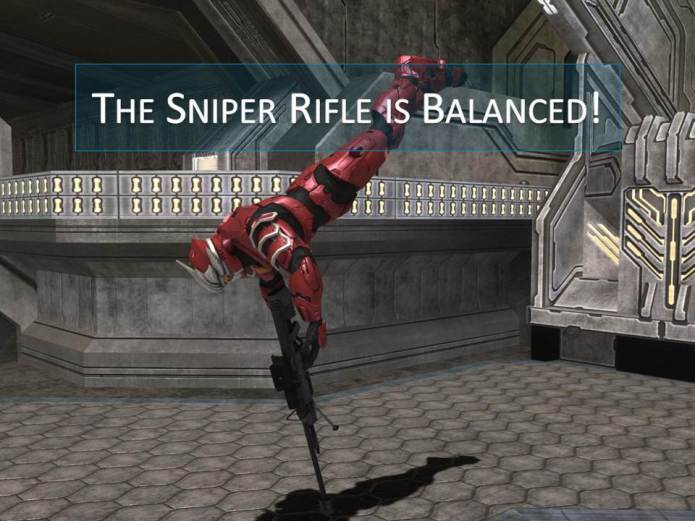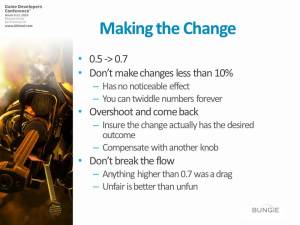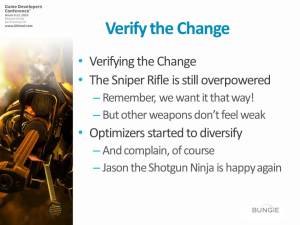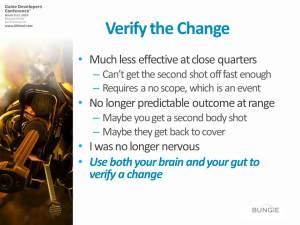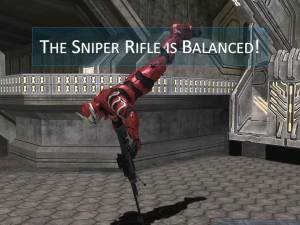
How do you develop your sense of balance for paper designs? It can be done, you can look at a paper design and have an intuition about how it will work. You are looking for the role, and for a couple key factors that are the results of the role.

The first thing you are looking for is to make sure the paper design is neither too simple, nor too complex. If your paper design is one sentence long, it is probably too simple. People are going to reach the limitations quickly and stop playing. (Remember, balance is longevity)
If it is more than a page long, it is likely too complex. People will never reach their comfort level, they will stop playing because they can’t understand what is happening. Balance is a barely manageable number of choices. (I bet I end up writing a post on this slide at some point.)

This is where roles come in because they provide depth without increasing complexity.
The Sniper Rifle is the best weapon in some situations. The Sniper Rifle has a clear role, times and situations where it is the best. The payoff for using the Sniper Rifle is different depending on what situation you are in. This is good, because game theory tells us that if all the possible strategies have the same payoff, players will pick randomly. As game designers we want to avoid choices that don’t ultimately matter.
Roles are also good because they cause asymmetry, which demand movement. There are incentives to move from one strategy to another depending on the situation.

One of the tropes of the design community… Rock, Paper, Scissors. But it’s a terrible game!!! Every choice has the same payoffs, so you pick randomly. There is no player agency if their choice is meaningless.
It’s a cool shirt, though (www.noisebot.com)
This was easily the most controversial slide in this talk. Several people took issue with the fact that RPS is a bad game because many journalists and designers improperly use it to describe a situation where one unit strictly dominates another, like in a good RTS. But imagine a RTS game where you could only pick one unit, you had to pick it before the game started, and if you picked wrong you couldn’t possibly win, It’d be a bad game!
The reason a RTS game works is because it isn’t RPS:
– You can play mixed strategies (choose more than one kind of unit)
– Strategies have different costs to play (tanks cost more than barbarians)
– You can change strategies mid-game
– Strategies rarely have an all-or-nothing payoff (10 Air units can usually kill 1 Anti-air unit)
So I am not using RPS in the casual sense of “a game with counter-strategies” but as defined in game theory; Hopefully that clears things up a bit.
I also got a lot of people saying, “RPS is the foundation of Street Fighter!” This is true, somewhat, more than the RTS case, anyway. but imagine a turn-based game of SF where the first hit wins the match. Again, a bad game.
The reason SF works is that it is also not really RPS:
-SF is a series of RPS interactions, so things like reputation and anticipation come in.
-It is played very quickly, so low level decision making and muscle memory determine your strategy more than choices, so it isn’t truly random.
-And even with that, most non-expert players tend to “button-mash” which is a great example of “random strategy”
Believe me, I am not trying to insult RTS games or SF (or even Ro Sham Bo Tournament Champions) but to encourage designers to see how roles lead to non-equal payoffs, and therefore avoid random strategies.


“Rock, Paper, Scissors, Lizard, Spock” is even worse game design. (This game is from the show “The Big-Bang Theory”) It looks more interesting, but it isn’t; it is just more complicated. It will still reduce to equal payoffs and random play.


This doesn’t even make sense! (Interesting note: Halo 1 was this close to shipping without a Shotgun, which makes even less sense…)

Avoid strict dominance…Wait, what is strict dominance?

Who picked the Health Potion? The single-use health replenisher you can buy for 30 rupees?
Who picked the Piece of Heart? The totally unique health-extender you can never buy?
Right, everyone picks the Piece of Heart. (If you didn’t, it’s ok, you were probably eight.)

Iterative deletion means you remove all the dominated strategies, then you remove all the strategies that were only good against those strategies. If you cut the Tank, cut the Anti-Tank Mine. Often when you are making cuts in the final stages of production, it seems like a good idea to cut a little bit from a lot of places, but it is uaully better to cut an entire game mechanic and all of the game elements that use it. Otherwise you end up with several systems that feel like they have missing pieces, rather than a single system that is entirely absent.

After GDC I got challenged to come with an example like Rock, Paper, Scissors that is good game design, so I invented Pirates, Ninjas, Sharks. Each has their own strengths. Ninjas are better at night, but Sharks always win in the water, while Pirates come in crews, etc. A good game is one that you can argue about forever.
[Continued]
